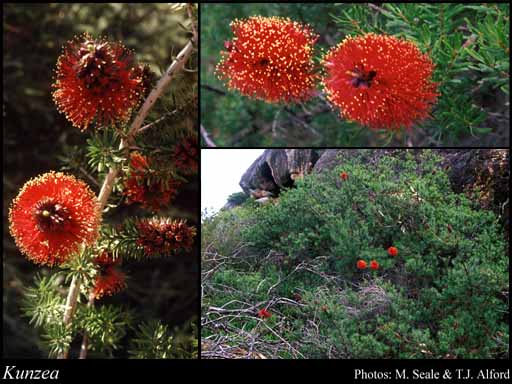- Reference
- Consp.Regn.Veg. 175 (1828)
- Name Status
- Current

Scientific Description
Common name. Kunzeas. Family Myrtaceae.
Habit and leaf form. Trees, or shrubs; evergreen; bearing essential oils. Plants with neither basal nor terminal concentrations of leaves. Young stems with or without stem flanges. To 0.3–4 m high. Leptocaul. Helophytic, or mesophytic. Leaves minute to small; alternate, or opposite (in a few species); ‘herbaceous’, or leathery; petiolate to sessile; gland-dotted; aromatic; with ‘normal’ orientation; simple; epulvinate. Leaf blades dorsiventral, or isobilateral, or centric; entire; flat, or solid; terete; linear, or lanceolate, or oblong, or ovate; linear, or ovate, or obovate, or oblong, or elliptic, or triangular, or orbicular; 1 -nerved, or 3 -nerved; pinnately veined, or parallel-veined, or one-veined; cross-venulate, or without cross-venules. Mature leaf blades adaxially glabrous, or pubescent, or villous; abaxially glabrous, or pubescent, or villous. Leaves without stipules. Leaf blade margins entire, or dentate. Leaves without a persistent basal meristem. Leaf anatomy. Hairs present, or absent. Stem anatomy. Secondary thickening developing from a conventional cambial ring.
Reproductive type, pollination. Fertile flowers hermaphrodite. Unisexual flowers absent. Plants hermaphrodite. Entomophilous, or ornithophilous. Pollination mechanism unspecialized.
Inflorescence and flower features. Flowers solitary (rarely), or aggregated in ‘inflorescences’ (usually); in heads. Inflorescences simple, or compound. The terminal inflorescence unit cymose. Inflorescences terminal (or ‘pseudoterminal’), or axillary; compact, usually globular, the terminal bud usually continuing growth after the fruit have been shed; with involucral bracts, or without involucral bracts; pseudanthial, or not pseudanthial. Flowers subsessile to sessile, or pedicellate (when solitary or in clusters of 2 or 3); bracteate. Bracts persistent, or deciduous. Flowers (bi) bracteolate. Bracteoles deciduous. Flowers small; regular; 5 merous; cyclic. Free hypanthium present (petals ‘inserted on the calyx’); campanulate (usually broadly cup-shaped), or globose (or ovoid); extending beyond ovary (where it is not much expanded); glabrous or silky or villous. Hypogynous disk present. Perianth with distinct calyx and corolla; 10; 2 -whorled; isomerous. Calyx present; 5; 1 -whorled; polysepalous, or gamosepalous (depending on interpetation); lobed; erect; imbricate, or valvate; exceeded by the corolla, or more or less equalling the corolla; regular; green; herbaceous nearly throughout or with a scarious margin; persistent (sometimes hardened in fruit). Sepals ovate, or triangular. Calyx lobes ovate, or triangular. Corolla present; 5; 1 -whorled; polypetalous; imbricate; regular; plain; pink to purple, or white to cream, or yellow. Petals obovate, or orbicular; shortly clawed. Androecial members indefinite in number. Androecium 20–100 (ie. ‘many’). Androecial members branched. Androecial sequence determinable, or not determinable. Androecial members maturing centripetally; free of the perianth; all equal; free of one another. Stamens 20–100 (ie. ‘many’); attached on the rim of the hypanthium; becoming exserted (and exceeding the petals); all more or less similar in shape; polystemonous; alternisepalous and oppositisepalous; both opposite and alternating with the corolla members; inflexed in bud (so that the anthers are below the stigma). Filaments not geniculate; filiform. Anthers all alike; dorsifixed; not erect; versatile; dehiscing via longitudinal slits; introrse; bilocular (cells parallel); tetrasporangiate; appendaged (the connective with a small globular gland (however little or no thickening of cells occurring at the back of the anther, so that when the pollen is shed the anther is left gaping)), or unappendaged. Gynoecium 2–5 carpelled. The pistil 2–5 celled. Gynoecium syncarpous; eu-syncarpous; inferior, or partly inferior. Ovary plurilocular; 2–5 locular. Epigynous disk absent. Gynoecium stylate. Styles 1; simple; from a depression at the top of the ovary; apical; much longer than the ovary at anthesis; becoming exserted; persistent. Stigmas 1; capitate, or peltate. Placentation apical (when ovules few and pendent), or axile (when ovules numerous). Ovules 2–50 per locule (i.e. few to ‘many’); pendulous (the placenta peltate in the upper part of the loculus); non-arillate; anatropous.
Fruit and seed features. Fruit non-fleshy, or fleshy (in K. pomifera); dehiscent, or indehiscent; a capsule, or capsular-indehiscent. Capsules loculicidal. Seeds non-endospermic; small. Cotyledons 2.
Geography, cytology, number of species. Native of Australia. Not endemic to Australia (one species in New Zealand). Australian states and territories: Western Australia, South Australia, Northern Territory, Queensland, New South Wales, Victoria, Australian Capital Territory, and Tasmania. South-West Botanical Province.
Etymology. After Gustav Kunze (1793–1851), professor of botany at Leipzig, entomologist and physician.